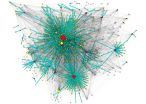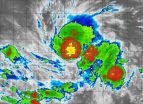(Press-News.org) Melbourne researchers have uncovered key steps involved in programmed cell death, offering new targets for the treatment of diseases including lupus, cancers and neurodegenerative diseases.
The research teams from the Walter and Eliza Hall Institute worked together to discover the three-dimensional structure of a key cell death protein called Bak and reveal the first steps in how it causes cell death. Their studies were published in Molecular Cell and Proceedings of the National Academy of Sciences.
Programmed cell death, known as apoptosis, occurs naturally when the body has to remove unwanted cells. Chemical signals tell the cell to die by activating the apoptosis proteins Bak and Bax, which break down the 'energy factory' of the cell, known as the mitochondria. When this process goes awry, defective cells such as cancer cells can continue to live, or healthy cells can die unnecessarily, such as occurs in Alzheimer's disease.
Visualising death proteins
Using the Australian Synchrotron, Mr Jason Brouwer, Dr Peter Czabotar, Dr Ruth Kluck and colleagues from the institute's Structural Biology division investigated how the structure of Bak changes in order to initiate cell death. The research was published in Molecular Cell.
"Understanding the way cell death proteins work and what they look like is crucial to finding new ways to treat disease," Dr Czabotar said. "Our research showed how Bak morphs from one shape to another to trigger apoptosis. Once Bak becomes 'activated' within the cell, it couples with another Bak molecule to form a 'dimer', which then goes on to initiate apoptosis."
Dr Czabotar said understanding apoptosis would allow researchers to develop new ways to treat disease. "Knowing the structure of these proteins and how they work in the cell is essential in designing new treatments to fight disease."
Seeking the hole story
Dr Dana Westphal, Dr Ruth Kluck, Dr Grant Dewson, Professor Jerry Adams and colleagues from the Molecular Genetics of Cancer and Cell Signalling and Cell Death divisions examined how the Bak and Bax dimers attach to mitochondria and perforate them. The research was published in Proceedings of the National Academy of Sciences.
Dr Kluck said dimers of Bak and Bax break open the mitochondrial surface, but the mechanism remains poorly understood. "A crucial stage of apoptosis is the release of key proteins from within the mitochondria," she said. "Scientists thought this happened by Bak and Bax poking through the mitochondrial membrane to form a hole, but our work has shown this doesn't happen. Instead, these proteins collapse onto the oily surface of the mitochondria and crowd the surface until holes form."
"We and others are now working to discover exactly how these proteins come together to destroy the mitochondria and trigger apoptosis. A deeper understanding of this pivotal event is likely to suggest new ways to regulate apoptosis to combat disease."
INFORMATION:
The research was funded by the Australian National Health and Medical Research Council, the Leukemia and Lymphoma Society (US), Australian Research Council, the Australian Cancer Research Foundation and the Victorian Government.
A matter of life and death: Cell death proteins key to fighting disease
2014-10-31
ELSE PRESS RELEASES FROM THIS DATE:
New step towards eradication of H5N1 bird flu
2014-10-31
A University of Adelaide-led project has developed a new test that can distinguish between birds that have been vaccinated against the H5N1 strain of avian influenza virus or "bird flu" with those that have been naturally infected.
This is a significant step in the fight against this often fatal strain of avian influenza which is widespread in the poultry populations of South East Asia, particularly Indonesia and Vietnam.
It causes global concern because of its possible transmission to humans and the threat of a pandemic if it mutates to a form that can be easily passed ...
'Divide and rule' -- raven politics
2014-10-31
Thomas Bugnyar and his team have been studying the behavior of approximately 300 wild ravens in the Northern Austrian Alps for years. They observed that ravens slowly build alliances through affiliative interactions such as grooming and playing. However, they also observed that these affiliative interactions were regularly interrupted by a third individual. Although in about 50 % of the cases these interventions were successful and broke up the two affiliating ravens, intervening can be potentially risky when the two affiliating ravens team up and chase away the intervening ...
Efficient genetic editing
2014-10-31
As potential next-generation therapeutics and research tools, few life sciences technologies hold more promise than genome-editing proteins – molecules that can be programmed to alter specific genes in order to treat or even cure genetic diseases.
There's at least one catch though – getting genome-editing proteins into cells, where they need to be to access the genome, is a major challenge, especially in live animals or human patients.
Conventionally, researchers have delivered the DNA encoding these genome-editing proteins into cells and then relied on ...
Countries can learn from Cyprus' 2013 economic crash, according to Imperial report
2014-10-31
In March 2013, Cyprus agreed to a €17 billion (£13.42 billion) international bailout by the International Monetary Fund (IMF), the European Central Bank (ECB) and the European Commission (EC).
The magnitude of the bailout was 100 per cent of Gross Domestic Product (GDP) and also involved a bank bail in. This is when the borrower's creditors are forced to bear some of the burden by having a portion of their debt written off in order for the bank to have sustainable level of debt.
The package of measures was aimed at preventing the country from facing the ...
Tweet much to gain popularity is an inefficient strategy
2014-10-31
The imbalanced structure of Twitter, where some users have many followers and the large majority barely has several dozen followers, means that messages from the more influential have much more impact. Less popular users can compensate for this by increasing their activity and their tweets, but the outcome is costly and inefficient. This was confirmed by an analysis of the social network performed by researchers from the Technical University of Madrid.
What can Twitter users do to increase their influence? To answer this question, a team of researchers at the Technical ...
Tropical Storm Vance's center looks like a pumpkin to NASA's Terra satellite
2014-10-31
Tropical Depression 21E strengthened overnight on Oct. 30 and by Halloween morning, Tropical Storm Vance was haunting the waters of the Eastern Pacific Ocean. In a false-colored infrared image from NASA's Terra satellite on Oct. 31, the strong thunderstorms around the center resemble a pumpkin.
Tropical Depression 21E formed on Oct. 30 after struggling for days as a low pressure area. Just a day later it strengthened into a tropical storm and was renamed Vance.
NASA's Terra satellite passed over Vance on October 31 at 4:55 UTC (12:55 a.m. EDT) – the witching hour ...
Raising cryptography's standards
2014-10-31
Most modern cryptographic schemes rely on computational complexity for their security. In principle, they can be cracked, but that would take a prohibitively long time, even with enormous computational resources.
There is, however, another notion of security — information-theoretic security — which means that even an adversary with unbounded computational power could extract no useful information from an encrypted message. Cryptographic schemes that promise information-theoretical security have been devised, but they're far too complicated to be practical.
In ...
The digital therapist
2014-10-31
WASHINGTON, D.C., October 31, 2014 -- Imagine this scenario: You've been feeling persistently blue lately, so you pull out your phone. Instead of asking Siri to tell you a joke, though, you open an app that records you simply talking about your day. A few hours later, your therapist sends you a message asking if you'd like to meet.
A program like this one that analyzes your speech and uses it to gain information about your mental health could soon be feasible, thanks in part to research from the University of Maryland showing that certain vocal features change as patients' ...
Report examines health care challenges for pregnant women enrolled in covered California
2014-10-31
WASHINGTON, DC (October 31, 2014) — A new report by Milken Institute School of Public Health (Milken Institute SPH) at the George Washington University examines the challenge of maintaining enriched health care for pregnant women who are enrolled in Covered California and who are also eligible for Medi-Cal, which includes the Comprehensive Perinatal Services Program (CPSP). The CPSP, whose roots are in one of the nation's most successful programs ever developed for low-income pregnant women, makes enriched maternity care available to pregnant women facing elevated ...
NYU research: Majority of high school seniors favor more liberal marijuana policies
2014-10-31
The United States is undergoing a drastic change in marijuana policy. Two states legalized recreational use for adults in 2012, and next week, citizens of Oregon, Alaska and the District of Columbia will vote for or against legalization in their area. The majority of the public now favor legalizing or decriminalizing marijuana use, but there is a lack of research examining how marijuana use and demographic characteristics relate to positions toward specific marijuana policies. For example, is it primarily marijuana users who support legalization?
There is a need to examine ...




